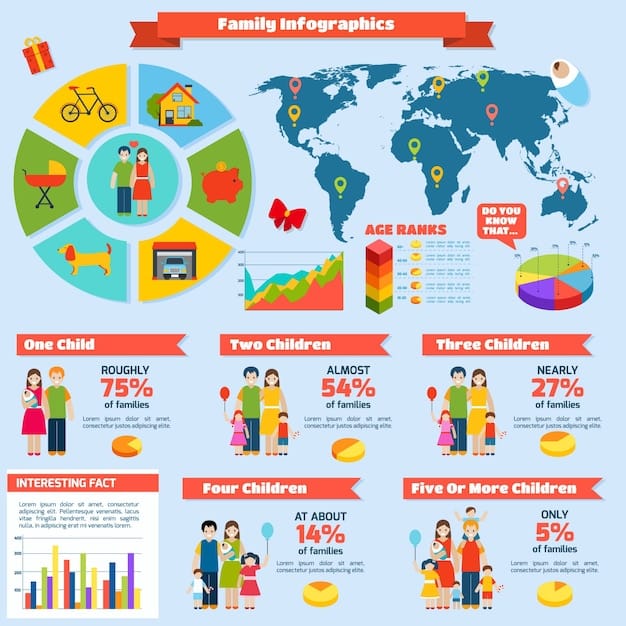Childcare Costs US: Budgeting and Saving Tips for 2025

Childcare costs in the US continue to rise, but families can budget effectively and save up to 15% in 2025 by exploring employer benefits, utilizing tax credits like the Child and Dependent Care Tax Credit, and considering flexible childcare options such as nanny shares or cooperative childcare.
Navigating childcare costs in the US: How to budget and save up to 15% in 2025 can feel overwhelming. However, with careful planning and smart strategies, parents can significantly reduce expenses and provide quality care for their children.
Understanding the Landscape of Childcare Costs in the US
The escalating costs of childcare in the United States pose a significant challenge for families nationwide. Understanding the factors driving these costs is the first step towards effective budgeting.
Regional Variations in Childcare Expenses
Childcare costs vary significantly across different states and metropolitan areas. Factors such as the local cost of living, demand for childcare services, and state regulations play a crucial role.
Factors Contributing to High Childcare Costs
Several factors contribute to the high cost of childcare, including staff salaries, facility expenses, insurance, and regulatory compliance. Quality childcare often requires significant investment in these areas.
- Location: Urban areas typically have higher childcare costs than rural areas.
- Type of Care: Daycare centers, nanny services, and in-home care options vary in price.
- Age of Child: Infant care is generally more expensive than care for older children.
- Program Quality: High-quality programs with experienced staff and enriched activities command higher fees.
Ultimately, understanding these regional variations and contributing factors is crucial for parents to accurately budget and explore potential savings strategies.

Creating a Realistic Childcare Budget
Developing a realistic childcare budget is essential for managing family finances effectively. This involves assessing income, identifying necessary expenses, and allocating funds accordingly.
Assessing Your Income and Expenses
Start by creating a comprehensive overview of your household income and expenses. Include all sources of income, such as salaries, investments, and other benefits, as well as regular expenses like housing, transportation, food, and utilities.
Prioritizing Childcare in Your Budget
Once you have a clear understanding of your financial situation, prioritize childcare within your budget. Determine how much you can realistically allocate to childcare expenses without compromising other essential needs.
- Calculate Net Income: Determine your monthly take-home pay after taxes and deductions.
- List Essential Expenses: Identify fixed costs like rent/mortgage, utilities, and transportation.
- Allocate Funds for Childcare: Set aside a reasonable amount for childcare based on available resources.
- Review and Adjust: Regularly review your budget and make adjustments as needed.
Budgeting is not a one-time task but a continuous process that involves monitoring expenses, adjusting allocations, and making informed financial decisions.
Leveraging Employer Benefits for Childcare Assistance
Many employers offer benefits that can help offset childcare costs. Exploring these options can provide significant financial relief and improve work-life balance.
Dependent Care Flexible Spending Accounts (DCFSAs)
A DCFSA allows you to set aside pre-tax dollars to pay for eligible childcare expenses. This can significantly reduce your taxable income and lower your overall childcare costs.
Employer-Sponsored Childcare Centers
Some companies operate on-site childcare centers or partner with local providers to offer subsidized childcare services to their employees. This can provide convenient and affordable childcare options.
- Pre-Tax Contributions: DCFSAs allow pre-tax contributions, reducing taxable income.
- Subsidized Care: Employer-sponsored centers often offer discounted rates.
- Backup Care: Some companies offer backup care services for unexpected childcare needs.
- Referral Services: Employers may provide resources to help find reputable childcare providers.
By taking advantage of employer benefits, parents can substantially reduce their childcare expenses and improve their financial well-being.

Utilizing Tax Credits and Deductions for Childcare
The federal and state governments offer various tax credits and deductions to help families with childcare expenses. Understanding and utilizing these benefits can result in significant savings.
Child and Dependent Care Tax Credit
The Child and Dependent Care Tax Credit is a federal tax credit that allows eligible taxpayers to claim a percentage of their childcare expenses. The amount of the credit depends on income and expenses.
State-Level Childcare Tax Credits and Deductions
Many states offer their own childcare tax credits and deductions, which can be claimed in addition to the federal credit. These state-level benefits vary depending on the state’s tax laws and budget.
- Eligibility Requirements: Review the income limits, qualifying expenses, and other requirements for each credit.
- Documentation: Keep receipts and records of all childcare expenses to support your claims.
- Tax Preparation: Consult with a tax professional to ensure you are claiming all eligible credits and deductions.
- Filing Deadlines: Be aware of the deadlines for filing your federal and state tax returns.
By maximizing tax credits and deductions, families can substantially reduce their childcare costs and improve their financial situation.
Exploring Flexible Childcare Options
Flexible childcare options can provide cost-effective alternatives to traditional daycare centers and nanny services. These options offer greater flexibility and affordability for families with diverse needs.
Nanny Shares and Cooperative Childcare
Nanny shares involve two or more families sharing the cost of a nanny, while cooperative childcare requires parents to take turns providing childcare for each other’s children. Both options can significantly reduce childcare expenses.
Part-Time Childcare and Drop-In Services
Part-time childcare programs and drop-in services offer flexible care options for parents who only need childcare on certain days or during specific hours. This can be particularly beneficial for parents with flexible work schedules.
- Cost Savings: Sharing a nanny or participating in a co-op can significantly reduce costs.
- Social Benefits: Children benefit from socializing with other kids in smaller settings.
- Flexibility: Part-time and drop-in services provide adaptable care options.
- Community Building: Co-ops foster community and mutual support among parents.
Exploring these flexible options can help families find childcare solutions that fit their budgets and lifestyles.
Long-Term Savings Strategies for Childcare
Planning for long-term childcare expenses requires a comprehensive financial strategy that includes saving, investing, and making informed decisions. These strategies can help families secure their financial future while providing quality care for their children.
Starting a Dedicated Childcare Savings Account
Open a dedicated savings account specifically for childcare expenses. Set up automatic transfers from your checking account to ensure consistent saving. Consider high-yield savings accounts to maximize interest earnings.
Investing in Tax-Advantaged Accounts
Explore tax-advantaged investment accounts, such as 529 plans or Coverdell ESAs, to save for future educational expenses, which can include childcare costs. These accounts offer tax benefits that can help grow your savings faster.
- Early Start: Begin saving as early as possible to take advantage of compounding returns.
- Automatic Transfers: Set up regular transfers to ensure consistent saving.
- Tax Advantages: Utilize tax-advantaged accounts to maximize savings.
- Financial Planning: Consult with a financial advisor for personalized guidance.
By implementing these long-term savings strategies, families can plan for the future and ensure they have the resources to provide quality childcare for their children.
| Key Point | Brief Description |
|---|---|
| 💰 Budgeting | Create a detailed budget to track income and expenses. |
| 🏢 Employer Benefits | Utilize DCFSAs and employer-sponsored childcare. |
| Tax Credits | Claim Child and Dependent Care Tax Credit. |
| 🤝 Flexible Options | Explore nanny shares and cooperative childcare. |
Frequently Asked Questions (FAQ)
▼
The average cost of childcare varies significantly by state and type of care, but it can range from $10,000 to $20,000 per year per child. Infant care is typically more expensive than care for older children.
▼
A Dependent Care FSA allows you to set aside pre-tax dollars to pay for eligible childcare expenses, reducing your taxable income and overall childcare costs. Contribution limits apply each year.
▼
The Child and Dependent Care Tax Credit is a federal tax credit that allows eligible taxpayers to claim a percentage of their childcare expenses, helping to offset the financial burden of caring for dependents.
▼
Flexible options include nanny shares, cooperative childcare, part-time childcare programs, and drop-in services. These options can provide cost-effective alternatives to traditional daycare centers.
▼
Start a dedicated childcare savings account, invest in tax-advantaged accounts like 529 plans, and consult with a financial advisor to create a comprehensive financial strategy for long-term childcare needs.
Conclusion
Managing childcare costs in the US: How to budget and save up to 15% in 2025 requires careful planning and proactive strategies. By understanding the landscape of childcare costs, creating a realistic budget, leveraging employer benefits, utilizing tax credits, exploring flexible options, and implementing long-term savings strategies, parents can effectively manage these expenses and provide quality care for their children while securing their financial future.





